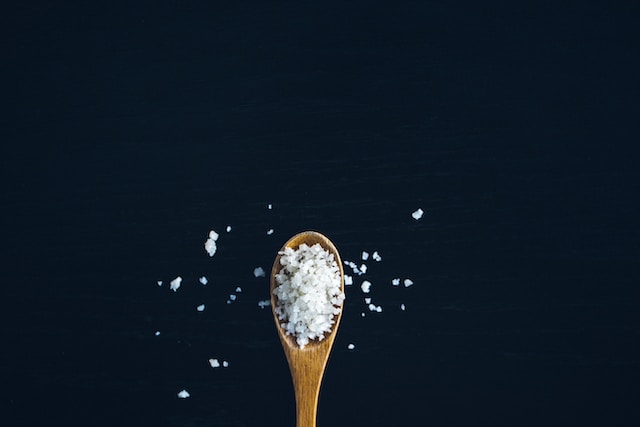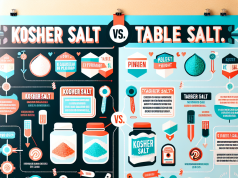Contents
The Science Behind Fine Salt vs. Coarse Salt in Your Favorite Recipes
Have you ever wondered why some recipes call for fine salt while others recommend coarse salt? The difference between fine salt and coarse salt goes beyond just their texture – it actually has an impact on the taste and texture of your dishes.
Fine salt has smaller granules than coarse salt, which means it dissolves more quickly and evenly in your food. This can be especially important in baking, where precise measurements are key to achieving the right consistency and texture. Coarse salt, on the other hand, takes longer to dissolve and can provide a crunchy texture or bursts of saltiness in dishes like salads or grilled meats.
Furthermore, the size of the salt crystals can affect the overall saltiness of a dish. Because fine salt packs more densely in a measuring spoon or cup, you may end up using less of it compared to coarse salt, which has larger crystals and takes up more space.
Ultimately, whether you choose fine salt or coarse salt for your recipes comes down to personal preference and the desired outcome of your dish. Experimenting with different types of salt can help you discover how each type affects the taste and texture of your favorite recipes.
Fine Salt vs. Coarse Salt
When it comes to cooking, the type of salt you use can make a significant difference in the final taste and texture of your dish. Fine salt and coarse salt are two common types of salt used in recipes, but what exactly is the difference between them?
Fine Salt
Fine salt, also known as table salt, is made up of very small, uniform crystals. These small crystals dissolve quickly and evenly in food, making them a popular choice for baking and cooking. Fine salt is also ideal for seasoning dishes at the last minute, as it disperses evenly and quickly over the surface of the food.
Coarse Salt
Coarse salt, on the other hand, is made up of larger crystals that take longer to dissolve. This can be beneficial in some recipes, such as in brines or when seasoning meats before cooking. The larger crystals can also provide a pleasing crunch and burst of flavor when sprinkled on top of a dish just before serving.
The Science Behind It
The difference in crystal size between fine salt and coarse salt can have a significant impact on your recipes. When fine salt dissolves quickly, it can distribute evenly throughout the dish, resulting in a consistent level of seasoning. Coarse salt, on the other hand, can provide pockets of intense flavor when it takes longer to dissolve, adding complexity to your dish.
Ultimately, the choice between fine salt and coarse salt will depend on the specific recipe and desired outcome. Fine salt is great for quick dissolving and even seasoning, while coarse salt can offer texture and bursts of flavor. Experiment with both types of salt in your favorite recipes to see which one works best for you!
For more information on the benefits of using different types of salt in cooking, check out this article from Food Revolution Network.
FAQs about The Science Behind Fine Salt vs. Coarse Salt in Your Favorite Recipes
What is the difference between fine salt and coarse salt?
Fine salt has smaller grains and dissolves more easily in liquids, making it ideal for baking and cooking where a smooth texture is desired. Coarse salt, on the other hand, has larger grains and adds a crunchy texture to dishes.
How does the size of salt grains affect the flavor of a dish?
The size of salt grains can impact how the salt is distributed in a dish and therefore affect the overall flavor. Fine salt disperses more evenly and is less likely to clump, while coarse salt may provide bursts of saltiness in certain bites.
Can fine salt and coarse salt be used interchangeably in recipes?
Yes, fine salt and coarse salt can generally be used interchangeably in most recipes. However, it is important to note that due to the difference in grain size, fine salt is more concentrated than coarse salt. So, if substituting one for the other, it is recommended to adjust the amount used.
Fine Salt vs Coarse Salt for Recipes
When it comes to cooking and baking, the type of salt you use can make a difference in the final outcome of your dish. Fine salt and coarse salt are two common types of salt that are used in recipes, but they have different characteristics that can affect the taste and texture of your food.
Fine Salt
Fine salt, also known as table salt, is finely ground and has a smooth texture. It dissolves quickly, making it ideal for recipes where you want the salt to evenly distribute throughout the dish. Fine salt is great for baking, as it can easily be incorporated into doughs and batters without leaving behind any grainy texture.
Coarse Salt
Coarse salt, on the other hand, has larger grains and a more textured feel. It doesn’t dissolve as quickly as fine salt, so it can add a crunchy texture to dishes when sprinkled on top. Coarse salt is often used as a finishing salt, adding a burst of flavor and crunch to salads, roasted vegetables, and grilled meats.
Ultimately, the choice between fine salt and coarse salt comes down to personal preference and the specific recipe you are making. Some chefs prefer the control and even distribution of flavor that fine salt provides, while others enjoy the added texture and flavor burst that coarse salt brings to a dish.
For more information on salt and its different varieties, you can visit Wikipedia’s page on Salt.
The Science Behind Fine Salt vs. Coarse Salt in Your Favorite Recipes
- Fine salt dissolves more quickly and evenly in liquids, making it ideal for baking and soups.
- Coarse salt adds a crunchy texture and bursts of flavor to dishes like salads and roasted vegetables.
- The choice between fine and coarse salt can affect the overall taste and texture of your recipes.
- Experiment with both types of salt to see which works best for your favorite dishes.








































